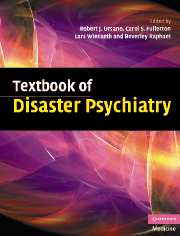Book contents
- Frontmatter
- Contents
- List of contributors
- Preface
- Part I Introduction
- Part II Foundations of disaster psychiatry
- Part III Clinical care and interventions
- 6 Early intervention for trauma-related problems following mass trauma
- 7 Acute stress disorder and post-traumatic stress disorder in the disaster environment
- 8 Assessment and management of medical-surgical disaster casualties
- 9 Interventions for acutely injured survivors of individual and mass trauma
- 10 Nongovernmental organizations and the role of the mental health professional
- Part IV Special topics
- Part V Public health and disaster psychiatry
- Index
- References
6 - Early intervention for trauma-related problems following mass trauma
from Part III - Clinical care and interventions
Published online by Cambridge University Press: 09 August 2009
- Frontmatter
- Contents
- List of contributors
- Preface
- Part I Introduction
- Part II Foundations of disaster psychiatry
- Part III Clinical care and interventions
- 6 Early intervention for trauma-related problems following mass trauma
- 7 Acute stress disorder and post-traumatic stress disorder in the disaster environment
- 8 Assessment and management of medical-surgical disaster casualties
- 9 Interventions for acutely injured survivors of individual and mass trauma
- 10 Nongovernmental organizations and the role of the mental health professional
- Part IV Special topics
- Part V Public health and disaster psychiatry
- Index
- References
Summary
Over the last decade, the field of post-traumatic early intervention has made a concerted effort to evaluate and recommend interventions that have the potential to attenuate suffering and/or facilitate recovery trajectories following mass traumatic events. Progress in this field has been beset by difficulties in obtaining empirical support, as well as lack of a conceptual framework in which to organize clinical, consensus, and research recommendations. Interventions in the immediate aftermath of mass traumatic events have received very little solid research support, and, in the absence of a theoretically derived organizing framework, interventionists often perceive two contradictory recommendations from “experts”: an “intervention for all” (e.g., group debriefing) strategy, and a “wait and see” strategy (i.e., do nothing before the passage of time reveals those in need of formal treatment from those who recover on their own). There are no comparative studies of the two different intervention strategies at this time, and limited data to support either strategy.
While other chapters in the volume have focused on long-term intervention strategies following disaster, this chapter addresses public mental health interventions in the immediate phase following disasters and mass violence. In most literature related to mass violence interventions (Shalev & Ursano, 2004), the immediate phase has been identified as 0–14 days postincident; intermediate phase, 14 days to 3 months; and the later phase, 3 months onward.
Keywords
- Type
- Chapter
- Information
- Textbook of Disaster Psychiatry , pp. 121 - 139Publisher: Cambridge University PressPrint publication year: 2007
References
- 4
- Cited by



